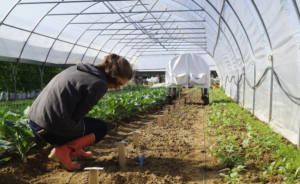The sustainability team at Sony CSL looks for novel technological solutions to create a more sustainable society. Two projects currently under development are the ROMI Rover and ROMI Plant Imager.
The ROMI Rover
Small, organic microfarms are on the rise. Although they have proven to be highly productive and sustainable, many struggle to remain economically viable. The ROMI Rover, a Europe-funded research project, aims to help these small farms by performing some of the most expensive and labour intensive work autonomously, cutting cost and increasing productivity.
All over Europe, young farmers are starting small market farms. These farms can be found in both rural and urban areas. They often grow a large variety of crops in a relatively small area using organic farming practices. Up to 100 different varieties of vegetables per year can grow in 0.01 to 5 hectares. Maintaining organic standards, and using no herbicides, means that much of the work is done manually, resulting not only in physically challenging work conditions, but also high labor costs.
To address this, Sony CSL has developed the ROMI Rover, an open source autonomous robot to assist microfarms in weed reduction and crop monitoring. This will reduce manual labour and help to ensure that these environmentally responsible farms can stay economically viable.
ROMI Rover can also acquire detailed information on crops and their progress, and can be paired with a Cable-Bot that acquires crop information on a larger scale. Together, they will produce an integrated, multi-scale picture of the crop development that will help the farmer monitor the crops to increase efficient harvesting.

The ROMI Plant Imager
Biologists are interested in phenotyping, the study of apparent aspects of plants such as the biomass or size of fruit, in order to correlate it with the genotype or environmental parameters.
Generally the equipment required to acquire the 3D architecture of a plant is quite costly and available only in large institutions.
The ROMI project is developing a robotic platform for the acquisition of a 3D image of a plant. It generates a “point cloud”: a large set of colored points in space that represents the original object. This will enable small laboratories to have easy and cost effective access to phenotyping technology in the lab. The ROMI Plant Imager also comes with a collection of 3D vision and machine learning based software, to analyse the data and extract plant traits such as the number of fruits and their sizes.
A companion plant carrier robot enables complete automation of the imaging operation for a batch of plants. It takes a plant from a storage area to the scanner and then carries it back to storage using a simple line following algorithm.
The ROMI Plant Imager is currently used indoors but we plan to take it outdoors into the field so that it can be used by agronomists and farmers, too.
Installation Details
On the installation you can see the primary functionality of the ROMI Rover, ROMI Plant Imager, and the Plant Carrier demonstrated. The rover moves across a bed of salad navigating autonomously, following the planted crops as a guide. It identifies the salad, then, using a rotating hoe, weeds between the salad to remove any unwanted weeds. Once complete it moves on to the next section.The plant carrier, our small autonomous robot, collects a plant, and following a path, places it in the scanner where a 3D scan can then be executed. Once complete the plant is returned to the growing area and another plant is selected for scanning.
Acknowledgements
The Robotics for Microfarm (ROMI) project has received funding from the European Union’s Horizon 2020 research and innovation programme under grant agreement No 773875. The consortium consists of: Iaac/FabLab Barcelona, CNRS (ENS Lyon), Inria, Humboldt University of Berlin, Chatelain Maraîchage, France Europe Innovation, Sony Computer Science Laboratories. More info here.
The Plant Carrier was developed at Sony CSL by Nicolas Branas, Paul Chambroux, Alexandre Leu, and Hugo Pasquier during a student project of the Polytech Sorbonne school, under the supervision of Pierre Carles and Fréderic Plumet. The 3D housing for the electronics were designed and printed by Farid Abderrahmane at AF-Tech. The chassis was built by Goubier Tolerie.



